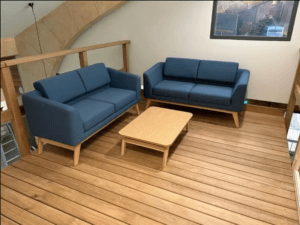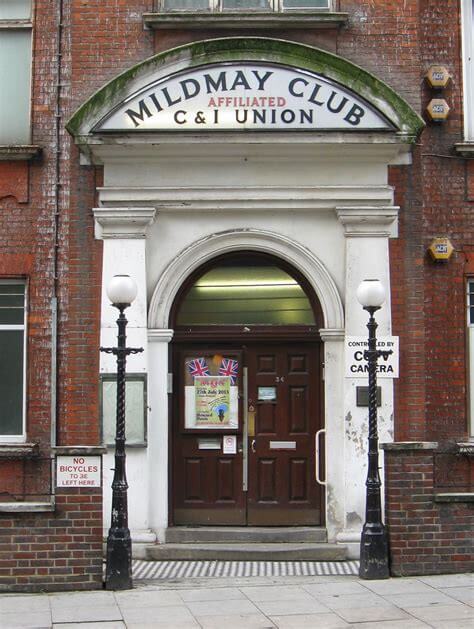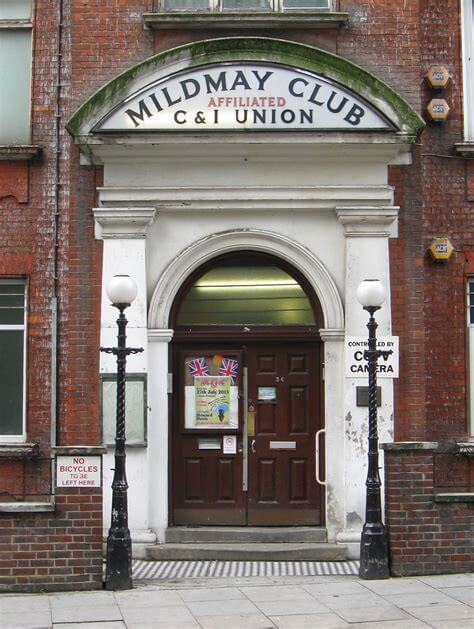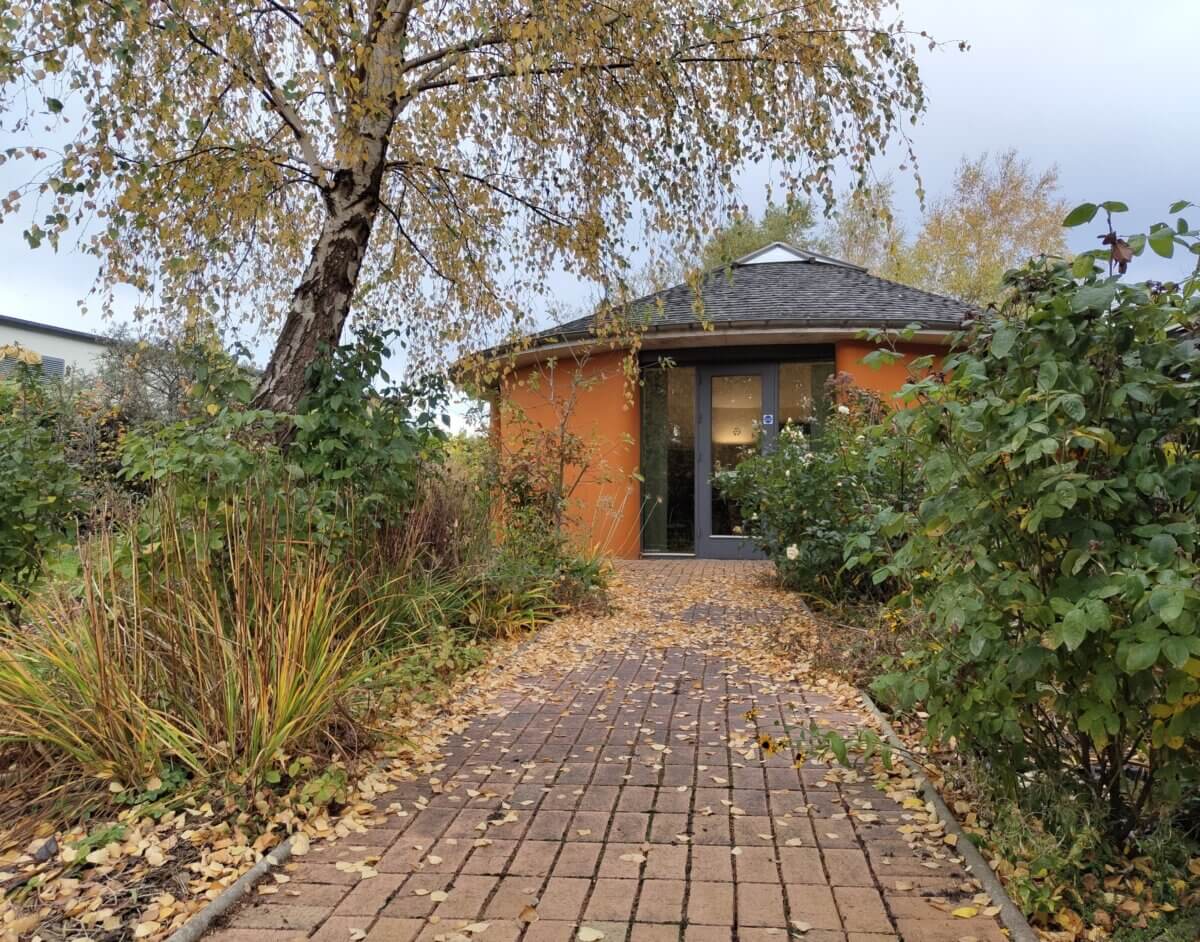Sustainable Office Refurbishment and Renovation

Ecology provides mortgages for eco-friendly renovation, retrofit and self-build projects that respect the environment, reduce carbon emissions and support communities. Sustainability is at the heart of our business, from lending to customers to the everyday running of our business. It’s not surprising, then, that we put our ethical principles into practice when it comes to managing the environmental impact of our workplace.
Workplace Sustainability
Much of Ecology’s business is based around supporting energy efficient and sustainable domestic housing. However, the principles we advocate around carbon emissions and reducing the environmental impact of construction through recycling and using more efficient forms of heating and better insulation also applies to the workplace and not least our own offices based in Silsden, West Yorkshire. Workplace sustainability has always been at the core of our operations and was the focus of our specification for expanded office accommodation which was put out to tender in 2000.
With the aid of our Facilities Manager Trevor Raddings, this article will look at the history of the building, its methods of construction and how the day-to-day running of the business is constantly working to maximise energy efficiency and reduce the environmental impact of our operations.
A Brief History of Our Offices
Ecology Building Society started trading in 1981 in a small office in the village of Cross Hills in North Yorkshire. By 1985, we had more than 1,000 investors and assets of £1.25 million. The first plans for expanded accommodation were discussed in 1994. Various sites in the area around the existing office were investigated but rejected until in 1998 a site in nearby Silsden site was identified as being ideal. The land was purchased in 1999 and an internal committee was formed to start the process of a new build design and move from the old site.
Three architects were short listed and Hodson Design were selected and the initial designs presented in late 2000 after a briefing by Ecology.
The project brief was based on:
- Functional requirements of the building
- Sustainability
- Environmental standards
- Ecological & building material content
- A building that was uplifting to the spirit
- Good/excellent quality
- Able to be expanded to suit future requirements over a 20 year period
- To act as an exemplar to how office developments can be more sustainable
- To publicise the work of the Society
Outline planning permission was sought and approved by Bradford Council in 2001. The location and orientation of the building was considered for natural lighting and heat absorption, plus the views of the site from office windows and garden site lines. An Otley-based construction company was appointed and building started in June 2002 and the building occupied in 2003.
An Exemplar of Office Sustainability

“Of course, if we were to do it now it would be done differently,” says Trevor, “technology has changed but, on the whole, the building has served its purpose well. It still does what it was supposed to do.” The original specification stipulated the building should have the ability to be expanded as needed over a 20 year period and this has been precisely Trevor’s job over the last couple of years. “When I came on board three years ago I was employee 39 on the roll now we have around 70.”
Very little had been done since the original build until Trevor led the new office refurbishment in 2023.
“We had probably about 38 desk spaces up to the summer of ‘22,” Trevor explained, “with individual offices, chief exec had his own office, the HR manager did, the Chief Operating Officer did. Everything was very compartmentalised. And then I got the brief to increase the numbers of desks and utilise the space better. So now we’ve got 54 desk spaces.”
You’d think additional desk space this would make the office feel cramped and stuffy, yet the whole building feels light and airy with convenient break-out areas, soundproof pods for privacy and quiet, a quiet Reflect room and a Focus work room. New hybrid working practices mean the pressure for desk space is less than it used to be. In fact, occupation levels are based on 7 desks for 10 people, counting on that some staff will always be off site, on sickness absence, on holiday, or working from home. As computers and computer monitors have shrunk in size, so too has the need for large office desks, freeing up more floor space.
“We’ve opened the whole place up now,” Trevor says, “and because of hybrid working we use an off-the-shelf desk and space booking system, Deskbird, to book a desk. So we’re not always sat at the same desk but can associate with other colleagues on work projects as the need arises. We can also book parking spaces for those who travel in electric or hybrid vehicles (EVs). The numbers of individual offices are down. Only the HR team has an office, everybody else has an open desk. This has allowed us to increase our meeting area space too with the creation of a Collaborate room equipped with AV technology and interactive whiteboards.

“Expansion doesn’t mean you have to build new offices, it’s about rethinking how the existing space is used, is it necessary, can I make better use of it? For instance, we used to have a reception desk which took up a lot of room and that’s gone now. We extended the mezzanine floor above what was a desk area and now is a cosy glass pod. It was once just open to the sky, whereas now it’s a little seating area. We’ve also created a breakfast bar overlooking the garden and we’ve got a couple more small breakout areas. The book shelves and the display shelves for all the awards we’ve won, they were made from reclaimed storage units where our colleagues used to keep their files and paperwork.”
Recycle/Reuse
The shelves are a pertinent example of Ecology’s commitment to sustainability; repurposing perfectly good natural materials and using a local joiner to do it. The same goes for the kitchen units: buying in the basic carcasses and using existing material from storage cabinets for door fronts and worktops. Simple but effective. As Trevor says:
“Everything we try and do, we try and keep within the ethos of the original design and its environmental impact. So all the furniture we’ve got all comes from sustainable sources. These sofas are partly made out of reclaimed plastic. Actually, the fabric is made from plastic pollution harvested from the ocean as part of the Seaqual Initiative [https://www.seaqual.org] All the carpet tiles, they’re made from nearly 80% recyclable material. All our lighting now is changed to LED. We’ve got lux and movement sensors, so we’re not wasting too much electricity. Although anyone who comes here will see there is so much natural light in this place that you rarely require light to be operating. During summer it’s brilliant!”
The building’s sustainability is not confined to the inside. The initial design also included a rainwater harvesting system. There is a sloped Sedum roof which funnels down the rain water, not just to drain pipes but suspended chains; it also creates a habitat for insects and birds. The harvested water goes into an underground tank and is used to flush toilets and water the garden. Two solar panel arrays located on the SE facing roof generate around 28% of Ecology’s annual usage, though that varies with winter and summer occupation.
Another feature of the site, and placed in a corner of the garden, is our stand alone Hill Room, a recycled shipping container used as a meeting and training & development room. It is self-sufficient electric wise, with infra-red heating panels above the internal ceiling and solar arrays on the roof. All internal fitting, apart from new electrical installations, were reclaimed from various sources; it is another great example of reclaim and reuse.
Achieving Net Zero
Ecology has long been committed to achieving net zero by 2030. This has now been brought forward to December 2025. It’s an ambitious target but Trevor believes it is eminently doable.
“The first project to do,” says Trevor, “is to remove the gas boiler and that will save something like six and a half thousand tons of CO2. We are also going to refurbish the two toilets which currently have showers fed by gas heated water and install point of use electric water heaters for the taps and put in electric showers. The old condensing boiler will be replaced probably with an Air Source Heat Pump with a ratio of four to one in its energy output but we will consider any options available to us that helps us meet our goals. This should make us a lot more energy efficient even though our electric consumption will go up as will our costs initially. But it’s better for us and the environment as all the electricity we use will be coming from a combination of solar panels and the grid which, through our supplier, is guaranteed 100% sustainable generated from solar and wind.”
Technology has moved on in recent years and can produce more efficient alternative heating systems which means the office can still hopefully use its existing radiators, as underfloor heating is not an option. With existing high levels of insulation and an airtight structure, it should be easy to maintain a comfortable ambient temperature all year round.
Monitoring is Key to Energy Efficiency
In order to maintain the energy efficiency of an office environment, Trevor is keen to emphasise the importance of monitoring.
“We have a number of sensors around the building. We monitor both ground floor and mezzanine floor temperature levels. We monitor hot water levels, water usage and also carbon dioxide levels; if and when they rise, we have the automatic opening windows to introduce more fresh air. We’ve also got auto light sensitive blinds to restrict solar glare. So it’s very well controlled.
“What really helps is having a good Building Management System (BMS) which takes all the sensor information and runs it through a mini computer that relearns itself. I have a desktop version that allows me to go in and change all the settings as needed, including adjusting the fresh air intake (we don’t have a cooling system so rely on air circulation), put holiday hours in and making sure if, for instance, we want to occupy on a Saturday I can bring the heating on.”
Transparency
It is clear that monitoring is important not only for energy efficiency but also for transparency. As an ethical provider, it is essential that our commitment to sustainability and carbon reduction can be objectively demonstrated. Everything is recorded on our intranet, from water and gas usage to solar generation and electricity usage night and day; even how much the EVs use for charging. (Ecology has a salary sacrifice scheme to encourage electric car use.) All of this information is regularly reported to the Board.
This commitment to monitoring sustainability and lowering carbon usage runs through the whole business: from using local suppliers where possible to understanding where suppliers get their materials and electricity from (what we call ‘embodied energy’ [link to Renovation blog]), where Ecology buys its energy from and how much carbon is used to generate that electricity.
Future Plans
So are there any future plans for Ecology’s offices? Trevor says:
“Besides the removal of the gas boiler, we’re looking at constructing some carports in the car park and put another solar array on the roofs. We’ve got planning permission for those and along with the existing panels the new arrays would give us probably 80 or 90% self-generated electricity to run our day-to-day usage. We are also considering battery storage to store for our night usage and EV cycle charging as well.”
Sustainability in the Workplace: Key Takeaways
- Prudent, forwarding-thinking planning is key. Ecology’s offices were planned with future expansion in mind and it has fulfilled its function well over the last twenty years.
- Best practices and high quality sustainable construction and insulation materials pay off in the long run.
- Source sustainable office furniture and flooring and recycle and repurpose existing materials where possible.
- Use local suppliers and manufacturers to reduce the carbon load.
Monitor, react and relearn to maximise energy efficiency.



